What Food Was Served On The Hindenburg
On May 6, 1937, the German airship Hindenburg crashed in Lakehurst, New Jersey, for reasons still unclear today (per History). To the horror of those watching from the ground, the 804-foot-long zeppelin was to land but instead burst into flames, marking the end of commercial airship travel (per Brittanica). Sadly, 35 of the 97 passengers died in the accident.
The Hindenburg was the epitome of luxury travel in its day, and passengers paid big bucks to fly. A one-way ticket cost $450 in 1937 (per the Smithsonian National Postal Museum). Today that ticket would cost almost $9,000 (per USD Inflation). You'd expect to be treated like royalty for that kind of money.
Sometimes the best part of travel is the food, and the passengers on the Hindenburg undoubtedly looked forward to finding out what foods they'd be dining on with excitement. With few things to do but look out the airship's windows at the ocean below, meals would take on a special significance and provide something for the guests to anticipate eagerly. What kind of food was served on the doomed Hindenburg?
Rich fare for rich folks
The ship's culinary sensibilities reflected the exorbitant ticket prices. According to a diary entry from a passenger on a previous Hindenburg flight — the airship made 63 flights before its last — a typical day for him on the zeppelin began with a simple breakfast: coffee, fruit, and bread baked on board (per Live Science). He recorded that soup and a choice of fish or chicken breast with rice, peas, and asparagus tips were on the menu. At the end of the meal, you could enjoy some ice cream, cake, and coffee (via Airships.net).
As noted by NPR, most dinners on board the airship included heavy German dishes such as Beef Broth with Marrow Dumplings and Rhine Salmon a la Graf Zeppelin, cold salmon with a spicy sauce, as per a claim on Chef Talk. Meals frequently included vegetables covered in gravies and sauces that were often too rich for the American passengers' palates. Those passengers were assured they could order a simple omelet instead of the heavier fare.
The dining decadence didn't end there. Guests could look forward to desserts such as the charlotte russe, a rich cake made with cream and ladyfingers served with coffee, before heading to the smoking lounge for digestifs or other nightcaps.
A well-provisioned flight
In the smoking lounge, guests could choose from various adult beverages, including a special drink called the LZ 129, a cocktail named for the lead ship in the Hindenburg class. If you had been overserved the night before, there was a hangover cure in the form of a raw egg and hot sauce on the menu. Meals were included in your ticket price, but drinks cost extra (per Atlas Obscura).
The chef onboard the Hindenburg was in charge of enormous amounts of food that had to feed passengers going from Germany to New Jersey and back again. These provisions included 800 eggs, 440 pounds of potatoes, and 440 pounds of canned goods among other staples (via Food Timeline). Meals came from a fully electric kitchen — no open flames allowed due to the presence of hydrogen used to launch the zeppelin (per Airships.net).
Even though the Hindenburg was considered a luxurious way to travel, guests were given one napkin to use for the voyage to reduce the weight of the airship. An envelope was provided for passengers to store the precious cloth and bring it to use at meals (via NPR).


